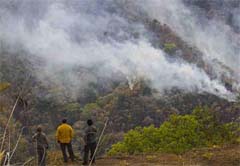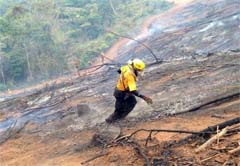When the forests burn in flames, be a hummingbird
by 14 lubica
The season of forest fires in Costa Rica has reached its peek. For the Guanacaste province, which has mostly dry climate and dry tropical forests, it means many fires, endless human efforts to fight against them under the hot sun conditions, and resulting loss of forest habitat, its fauna and flora on thousands of hectares.
Many people say that this year has been worse than usual. According to SINAC (Costa Rican National System of Conservation Areas), in the first four months of 2015 over 1202 hectares of protected areas fell victim to fires which is 500 hectares more than over the same period last year.i Since the beginning of April, the volunteer firefighters and SINAC- officials were on full alert tirelessly fighting side-byside for the forests in Diria National Park, Corral de Piedra Wetland, Cerros de Jesús - private nature reserve and Barra Honda National Park.

When the smoke covers forest horizons in Diria National Park. Photo by Ariana Crespo.
The staff at the Tempisque Conservation Area suspected that many of the fires were set intentionally. There are unfortunate cases, when poachers and hunters set up fires to chase the wildlife out of the burning environment. In other scenarios, some farmers use it as a means to avoid the strict forest law regulations that prohibit a land use change if there is forest cover. The law was created in the 90s to incentivize reforestation and forest protection. In the practice, on private forestlands, farmers often feel as “expropriated” having no right to choose a different economical activity.
In other cases, the fires spread from lands where farmers use burning in their agriculture or waste disposal. People speak about the persisting culture of burning in Guanacaste.
Whether it is intention or negligence of people, the Tempisque Conservation Area has the worse record of forest fires in the whole country. The dry conditions in forests help spreading the fires on thousands of hectares. The flames trap many animals, leaving them without any chance of rescue. The situation affects also peasants and forest producers who own private farms with forestland. The fires have devastating effects on their livelihoods.
Over the past few weeks, when the situation became everyday reality in Guanacaste, many spoke about the shortage of staff, volunteer firefighters, lack of funding, equipment, water and food for brigades, to mention just some of the challenges they face. Frustration and anger filled people’s hearts when they hopelessly watch forests burn and think about 25- 30 years of forest restoration lost in the flames.

Forest fires have torn more than 2000 hectares of protected areas this year. Courtesy of Bomberos Forestales CR
When facing seemingly impossible challenges, I always remember the story of Wangari Maathai “I will be a hummingbird.”ii A hummingbird, the smallest of all animals saw how a huge fire hit a forest and how other animals watched it helplessly. But the brave hummingbird kept bringing water to the flames in the tiniest amounts. He was doing the best he could.
And just like him, many people tirelessly responded to the crises of forest fires in Guanacaste. Money and food donations, endless work of volunteer firefighters, concern of the entire community. The rain season is starting which means that the nature will help in the battle against forest fires as well. But it is important to collect lessons learnt and good practices and undertake preventive measures to be better prepared for the fire season in the future. We all should adopt the “hummingbird approach” of doing the best we can.
References:
i See also: http://www.sinart.go.cr/rtn-noticias/nacionales/item/1567-incendios-forestales-se-hanintensificado-en-esta-epoca-del-ano
ii Wangari Maathai: „I will be a Humming Bird watch at: href="https://www.youtube.com/watch?v=IGMW6YWjMxw
 15-07-07 06:35:00 pm,
15-07-07 06:35:00 pm,
Neueste Kommentare